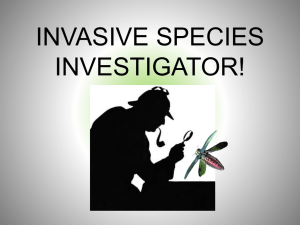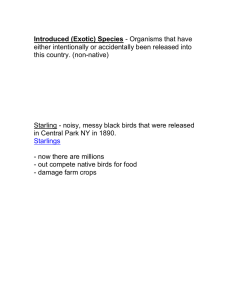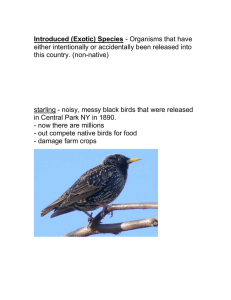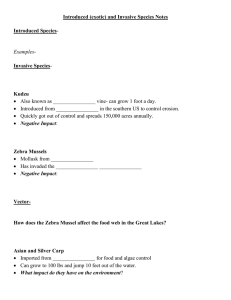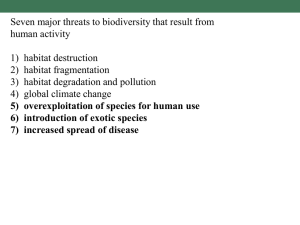Invasive Species (As previously published in The Delmarva Farmer)
advertisement
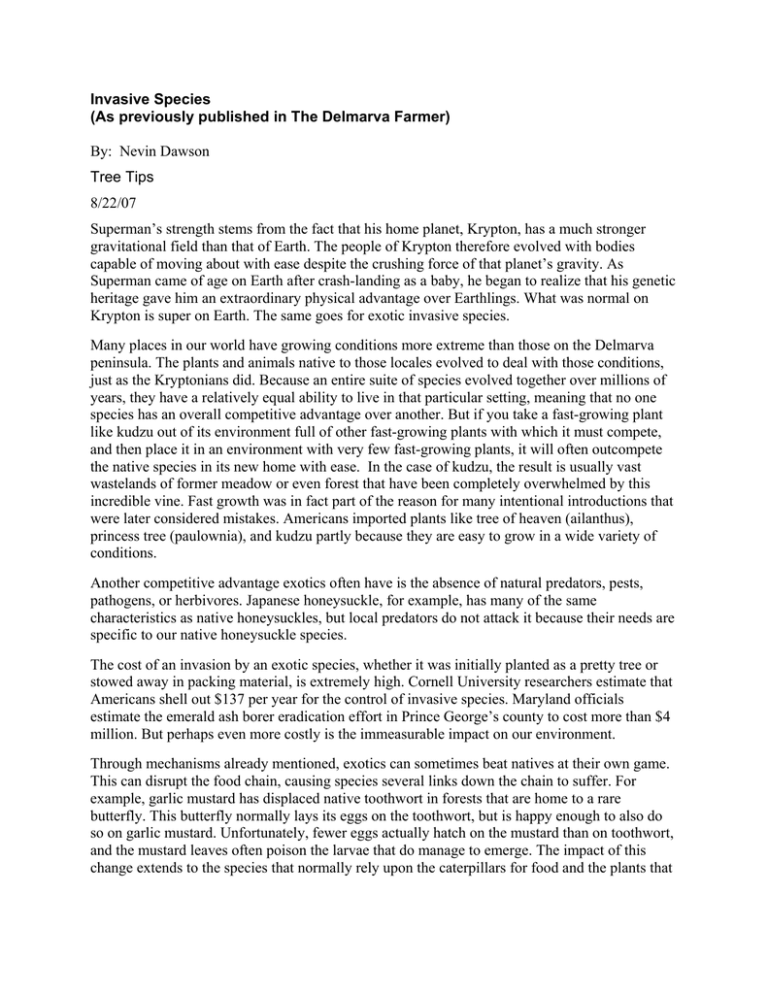
Invasive Species (As previously published in The Delmarva Farmer) By: Nevin Dawson Tree Tips 8/22/07 Superman’s strength stems from the fact that his home planet, Krypton, has a much stronger gravitational field than that of Earth. The people of Krypton therefore evolved with bodies capable of moving about with ease despite the crushing force of that planet’s gravity. As Superman came of age on Earth after crash-landing as a baby, he began to realize that his genetic heritage gave him an extraordinary physical advantage over Earthlings. What was normal on Krypton is super on Earth. The same goes for exotic invasive species. Many places in our world have growing conditions more extreme than those on the Delmarva peninsula. The plants and animals native to those locales evolved to deal with those conditions, just as the Kryptonians did. Because an entire suite of species evolved together over millions of years, they have a relatively equal ability to live in that particular setting, meaning that no one species has an overall competitive advantage over another. But if you take a fast-growing plant like kudzu out of its environment full of other fast-growing plants with which it must compete, and then place it in an environment with very few fast-growing plants, it will often outcompete the native species in its new home with ease. In the case of kudzu, the result is usually vast wastelands of former meadow or even forest that have been completely overwhelmed by this incredible vine. Fast growth was in fact part of the reason for many intentional introductions that were later considered mistakes. Americans imported plants like tree of heaven (ailanthus), princess tree (paulownia), and kudzu partly because they are easy to grow in a wide variety of conditions. Another competitive advantage exotics often have is the absence of natural predators, pests, pathogens, or herbivores. Japanese honeysuckle, for example, has many of the same characteristics as native honeysuckles, but local predators do not attack it because their needs are specific to our native honeysuckle species. The cost of an invasion by an exotic species, whether it was initially planted as a pretty tree or stowed away in packing material, is extremely high. Cornell University researchers estimate that Americans shell out $137 per year for the control of invasive species. Maryland officials estimate the emerald ash borer eradication effort in Prince George’s county to cost more than $4 million. But perhaps even more costly is the immeasurable impact on our environment. Through mechanisms already mentioned, exotics can sometimes beat natives at their own game. This can disrupt the food chain, causing species several links down the chain to suffer. For example, garlic mustard has displaced native toothwort in forests that are home to a rare butterfly. This butterfly normally lays its eggs on the toothwort, but is happy enough to also do so on garlic mustard. Unfortunately, fewer eggs actually hatch on the mustard than on toothwort, and the mustard leaves often poison the larvae that do manage to emerge. The impact of this change extends to the species that normally rely upon the caterpillars for food and the plants that rely on the butterflies for pollination. This is only one small example of the sort of chain reaction that is likely to happen in any case where exotics have displaced natives. So how do we control these species with superpowers? An ounce of prevention is the easiest way. This begins with inspections, fumigations, and quarantines of imports, but extends to practices you can incorporate into your everyday life. These include buying firewood for camping where you intend to burn it rather than possibly carrying a pest hitchhiker from your home into a new area, and removing all weeds from your boat and trailer before leaving the area to prevent spreading exotics from one lake to another. Once an invasive has been established, the control measures required are often intensive and prolonged. Check with your local extension agent for recommendations for a specific species, but always plan to actively replace the exotic with a native species. Even complete eradication may be useless if you leave the site open to a new infestation by not filling the gap with your species of choice as soon as possible. The control of invasive exotic species can be intimidating. An understanding of how they thrive and what their effects are can help you prevent the initial establishment of these plants with abilities that can seem out of this world.

